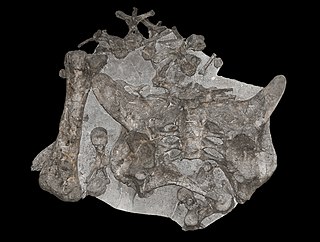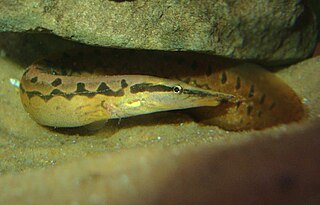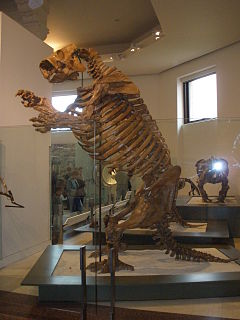Related Research Articles

Year 477 (CDLXXVII) was a common year starting on Saturday of the Julian calendar. At the time, it was known as the Year after the Consulship of Basiliscus and Armatus. The denomination 477 for this year has been used since the early medieval period, when the Anno Domini calendar era became the prevalent method in Europe for naming years.

Hylaeosaurus is a herbivorous ankylosaurian dinosaur that lived about 136 million years ago, in the late Valanginian stage of the early Cretaceous period of England.

Dacentrurus, originally known as Omosaurus, is a genus stegosaurian dinosaur from the Late Jurassic to Early Cretaceous of Europe. Its type species, Omosaurus armatus, was named in 1875, based on a skeleton found in a clay pit in the Kimmeridge Clay in Swindon, England. In 1902 the genus was renamed Dacentrurus because the name Omosaurus had already been used for a crocodylian. After 1875, half a dozen other species would be named but perhaps only Dacentrurus armatus is valid.

Enoplosus armatus, commonly referred to as the old wife, is a species of perciform fish endemic to the temperate coastal waters of Australia. It is the only modern species in the family Enoplosidae.

The abyssal grenadier, Coryphaenoides armatus, is an abyssal fish of the genus Coryphaenoides, found in all the world's oceans, at depths between 800 and 4,000 m. Its adult length is 20 to 40 cm, although Fishbase gives lengths up to 1 m. The abyssal grenadier's body is unique in that it contains two dorsal spines and about 124 dorsal soft rays, which are the flexible jointed rays supporting a fin nearest to the back in the spinal column. It has no anal spines, but has 115 anal soft rays along its body. The head and eyes of this fish are very large, while the mouth is very small. The color of the abyssal grenadier is brown apart from the abdomen, which is bluish.

Portunus trituberculatus, the gazami crab, South Korea's blue crab or horse crab, is the most widely fished species of crab in the world. It is found off the coasts of East Asia and is closely related to Portunus armatus.
Flavius Armatus, also known as Harmatius, was a Byzantine military commander, magister militum under Emperors Leo I, Basiliscus and Zeno, and consul. He was instrumental in the rebellion of Basiliscus against Zeno, and in his subsequent fall.

The Uinta ground squirrel, commonly called a "chisler" and Potgut in northern Utah, is a species of rodent native to the western United States.

The zig-zag eel, also known as the tire-track eel, tire-track spiny eel or marbled spiny eel, is a species of ray-finned, spiny eels belonging to the genus Mastacembelus of the family Mastacembelidae, and is native to the riverine fauna of India, Bangladesh, Pakistan, Sri Lanka, Thailand, Vietnam, Indonesia and other parts of South East Asia. The species was described as Macrognathus armatus by Lacepède in 1800. Other common names for this popular aquarium species are leopard spiny eel and white-spotted spiny eel. This species is not only a popular aquarium fish but also as a food fish in its country of origin.

The breaksea cod, black-arse cod or tiger cod, is a species of marine ray-finned fish in the family Serranidae, the groupers and sea basses. It is endemic to Australia. Its natural habitats are open seas, shallow seas, subtidal aquatic beds, and coral reefs. This species is the only member of its genus.

Lestodon is an extinct genus of megafaunal ground sloth from South America during the Pliocene to Pleistocene periods. Its fossil remains have been found in Argentina, Paraguay, Uruguay, Venezuela, Bolivia, and Brazil. Measuring approximately 4.6 metres (15 ft) from snout to tail tip, it is estimated to have weighed 2,590 kilograms. It was a herbivore and primarily fed on the grasses on the South American plains and is thought to perhaps have used its semi-bipedal stance to obtain foliage from trees. Lestodon is placed as member of the Mylodontidae as indicated by the lobed form of the last tooth in the dentition.

Sclerosaurus is an extinct genus of procolophonid parareptile known from the Early to Middle Triassic of Germany and Switzerland. It contains a single species, Sclerosaurus armatus. It was fairly small about 30 cm long, distinguished from other known parareptiles by the possession of long, backwardly projecting spikes, rear lower jaw teeth with slightly imbricating crowns, and a narrow band of back armor comprising two or three rows of sculptured osteoderms on either side of the midline.

Pagurus armatus, the armed hermit crab or black-eyed hermit crab, is a species of hermit crab found in the eastern Pacific Ocean of the United States and British Columbia, Canada.
Microsynodontis armatus is a species of upside-down catfish endemic to Gabon where it occurs in the Ivindo River. It was first described in 2004 by Ng Heok Hee.
Onoulphus, also Onoulf, Unulf and Hunulf was a general of the late fifth century of Scirian origin. He served as magister militum per Illyricum from 477 to 479 as a general of the Eastern Roman Empire, then afterwards was a general for his brother Odoacer, king of Italy, until their death.
The bony-eared assfish is a bathypelagic species of cusk-eel found in tropical and sub-tropical oceans at depths of from 1,171 to 4,415 metres. It has been found as far north as Queen Charlotte Sound off British Columbia's coast. This species grows to a length of 37.5 centimetres (14.8 in) SL. It is the only known member of its genus Acanthonus.
Basiliscus was the only son of the East Roman (Byzantine) military commander Armatus and briefly caesar of the East Roman Empire in 476–477/8. In later life, he became a priest and finally bishop of Cyzicus.
Petrolisthes armatus, the green porcelain crab, is a species of small porcelain crab in the family Porcellanidae. It is believed to be native to Brazil but has spread to other parts of the world. Populations in the south eastern part of the United States have increased dramatically and the species is considered to be an invasive species.
Sympleurotis albofasciatus is a species of beetle in the family Cerambycidae. It was described by Julio and Monné in 2005. It is known from Mexico.
Sympleurotis wappesi is a species of beetle in the family Cerambycidae. It was described by Julio and Monné in 2005. It is known from Guatemala.
References
- ↑ BioLib.cz - Sympleurotis armatus. Retrieved on 8 September 2014.